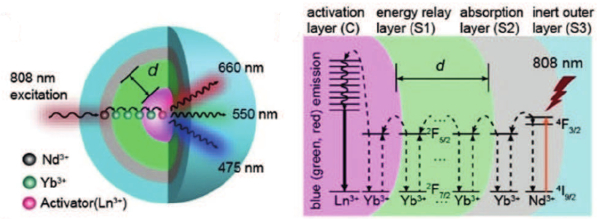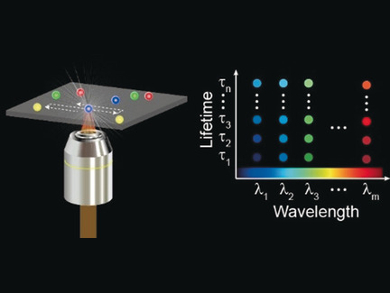In so-called optical multiplexing, multiple optical signals are generated by an irradiated material. This is useful in biological assays or security detection technologies. However, conventional optical codes based on fluorescent color and intensity offer a limited number of possible codes.
Fan Zhang, Fudan University, Shanghai, China, and colleagues have developed a new multiplexing concept that allows the luminescence emission color and decay lifetimes of upconversion nanoparticles (τλ-UCNPs) to be manipulated separately. This color/lifetime strategy has an exponentially scalable encoding capacity, three orders of magnitudes higher than that of the conventional color/intensity method.
An epitaxial growth method was used to synthesize τλ-UCNPs (pictured below). They are composed of an activation core (C) which is co-doped with Yb3+ and a Ln3+ activator, an energy relay layer (S1), an energy absorbance region (S2), and an inert outer layer (S3).
Upon excitation with light at 808 nm, energy is absorbed and transferred to the core of the τλ-UCNPs. There, distinctive emissions are generated, which can be altered by doping different lanthanide ions into the core. Tuning the thickness of the nanoparticle shell produces blue (475 nm), green (550 nm), or red (660 nm) emissions with at least six distinguishable lifetimes. The τλ-UCNPs could have applications, e.g., in human papillomavirus (HPV) subtype detection, or as a component of security inks for use in anti-counterfeiting materials.

- High-Capacity Upconversion Wavelength and Lifetime Binary Encoding for Multiplexed Biodetection,
Lei Zhou, Yong Fan, Rui Wang, Xiaomin Li, Lingling Fan, Fan Zhang,
Angew. Chem. Int. Ed. 2018.
https://doi.org/10.1002/anie.201808209


